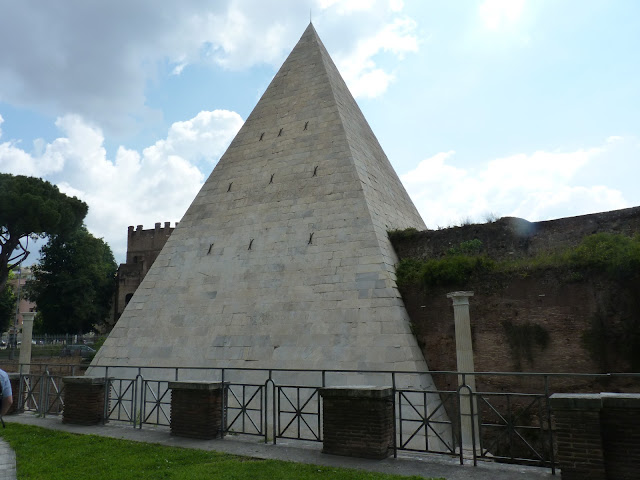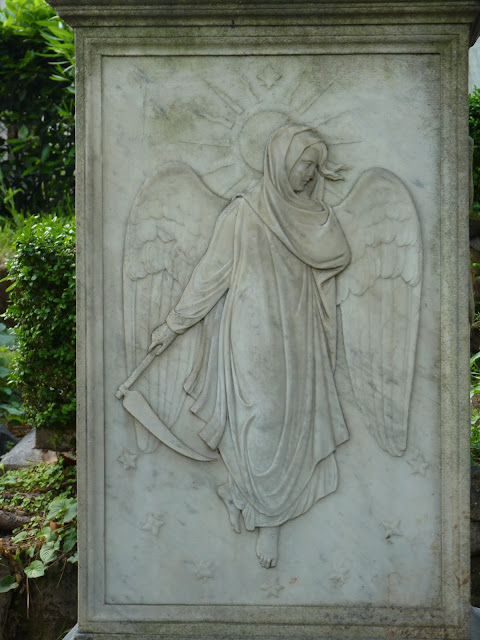Tuesday, July 30, 2019
Ostica Antica: Part 2--Bricks Bricks Bricks
Millions of ancient, handmade bricks. I'm sure the Romans builders must have known processes to speed the work; molds, patterns or cutting techniques? But I was fascinated. I loved the color--a deeper red than these photos appear.
Texture. Really, I was looking for a thumb print or other marks of the Ancient human makers of these bricks.
Uniqueness. Each brick is a creation unto itself.
Some of the bricks appeared more uniform; better quality than others. Like all things people make.
Interesting surface on the one above. Also, I looked for a scratched-in message. Didn't find any, but didn't look all day; spent a good half-hour examining bricks.
Never meant to be seen: the bricks were meant to be covered with facing stone like marble; long gone.
Like tiny caves in landscape. It's only a matter of scale?
Eventually, I had to stop looking for the Roman Slave "Kilroy" and go on to the Museum.
Often, I am the shallowest of tourists: ask my husband; all I want to do is go find a cup of coffee.
Other times, I obsess over some small detail, important only to me.
Thursday, July 25, 2019
Ostia Antica: One of Two Day Trips We Made Out of Rome (Part 1).
A short train ride--perhaps 10 miles from Rome--Ostia Antica is situated at the mouth of the Tiber River at the Mediterranean Sea. For the Ancients, it was the port city for Rome: goods received, counted and repacked for transport by boat into the City. Here's where all that olive oil came in to be shipped to the City; as well as grain and so much more.
During the Dark Ages, Medieval Era, etc., Ostia was mainly deserted and buried in time. Though marble and other precious things were taken or looted for reuse.
The lay out of the brick and stone foundations paints a great outline of the Ancient Port Town.
After a month or more, I find these memories so interesting and--my favorite word: evocative.
All the bricks were hand made in Ancient Time! So many bricks.
Designs and details everywhere you look. Just wait till we visit the Museum.
Sunrise? with or without skulls.
Niches for burial remains outside the town of Ostia. The Romans didn't put their cemeteries within their towns, I have read.
Saturday, July 20, 2019
Testaccio: The Waste Dump of Ancient Rome
A bustling, slightly "urban gritty" section of the city scene; most people did not appear fresh off the plane from the US (like us), but seasoned residents of the city, young and old alike. There seemed to be more local people just living their lives in Rome.
Lots of store front businesses, restaurants, coffee bars, hair and nail salons, car repair shops and even custom dress makers shops. After being home for a month or more, I realize that most of the better restaurants we experienced were in Testaccio; more diverse than the usual pizza and pasta of Trastevere.
In the Ancient City, Testaccio was an "out-skirt" of the Central City, it was used as a garbage dump of a particular kind: crockery jars that were used to transport and store olive oil could not be re-used because the oily residue in the jar would go rancid and smell bad. Those jars were brought to Testaccio. Over the many centuries these built up into a huge hill of many acres of size---and it stunk!
The sizeable base of the hill is now ringed by one of the most interesting and evocative streets you'll every see. A hodge-podge of old houses, apartments, store fronts, restaurants, bars, little work shops, more car repair shops, etc. etc. If there is one place I did not take enough photos.....
Looking up the hill, you can see the row upon row of broken and stacked crockery. The Park is only open at lect times, like Sunday afternoons? or else we would have explored further. Just another place where you can imagine the many generations of workman--probably slaves--breaking and stacking the jars, the smell of the oil--does the residue of the oil still seep out after a big rain??
The emblem of this area.
And just some of the (probably thousands?) of 19th and early 20th Century apartment blocks built to house the workers of those times. So old that they were built without elevators, most probably still without. Laundry and bedding hanging out the windows to air or dry. No screens on the windows? How do they not have mosquitos? Rome was once subject to malaria... hunh. Something else to wonder about.
Wednesday, July 17, 2019
Not Far from the Non-Catholic Cemetery and Parco Testaccio: Our Destination. And my Favorite Statue.
"The Power Station Museum": Musei Capitolini Centrale Montmartini. At first, the unversed like me, might think we were going to visit something with "Mussolini" in it. It's true, the setting for this vast array of beautifully displayed artifacts is a 20th Century power generation plant, complete with machinery (cleaned, painted and impressive).
The funerary sculpture above depicts a baker and his wife from Roman antiquity, featured in discussion by Mary Beard in her television series about lives of the Romans. "I was a baker. Get It."
Musei Centrale Montmartini, in the lofty, uncrowded, airy setting of the old power plant, off the beaten track in Testaccio was a place I'd like to return to (better prepared) for a dedicated "day long" visit.
This place definitely fit my goal of avoiding "tourist meccas": we arrived midday on a weekday in May. We virtually had the place to ourselves, accept for a few sedate, stylish-looking people who appeared to be Italian or European, maybe artists or academics. (Haha, we were likely the gawky tourists in the mix that day! Except our son: he's an academic.)
Leave out my reflection in the glass, the bronze at the left in identified as Julius Caesar's grandson, Gaius, son of Julia. It is rare when you see anything but an "Unknown Roman".
For Hubsy, there was a huge room dedicated to the display of the Pope's 19th Century rail cars.
Sadly, even though the room was large, there was no way to frame the entire assembly.
Hello Lovely Girl!
Meet "The Muse, Polimnia"
The statue was labelled as a Hellenic or Greek image.
My favorite statue from what I saw in Rome.
Look at her. Whose little teenage daughter, very young new wife, little sister, favorite niece, perfect model (or beguiling young slave, dancer, lover, etc) was she? Her cute little foot peeping out from her robes. Informal posture. Lazy chignon.
I want this for my flower garden. In the thousands of years she has existed, who else has wanted her in their flower gardens? That kind of speculation is, for me, "What Rome Is All About"; everywhere you look you see something that makes you wonder.
I wonder if other statues like this, a set perhaps, once existed as decoration of some wealthy man's estate.
Of course, like so many other statues, it is damaged. I wish the images were not damaged and defaced.
Friday, July 12, 2019
Two More "Bonus Sights", (still on the long march to our destination--more when we get there)
The Pyramid of Cestius, erected just prior to the "common era" or birth of Christ, the tomb was so massive that this portion of the Roman Wall incorporated it. Over 2,000 years old, it was recently restored and cleaned up.
I knew about the Non-Catholic Cemetery of Rome as the grave site of English poets and some of their families and friends; there is so much to see in Rome, I did not think it would be likely to visit.
But our energetic tour guide and youngest son, Ian, managed to steer us in this direction as we walked to the museum that was our goal.
There cannot be a "happy cemetery", but this one is so evocative, with so much history, in such a fabulous location, so beloved and tended! This area, near the Pyramid, is a "Poets Corner" with people like Keats and Shelley, etc. could certainly be inviting to people who love the works of these writers.
There were places to sit: contemplate your surroundings? read a poem or story of your favorite writer? (It reminded me of the William Faulkner home in Oxford, MS: the yard is furnished with lots of chairs where people can think about the writer, read or discuss his work with others.)
The main section of the cemetery is devoted to thousands of Protestants, Jewish people and others who died in Rome or intended to be interred here.
Impressive displays of lovely tomb art, worthy of a visit on their own merits.
Modern works, too.
We spent nearly an hour here--admission is "free" but they expect and appreciate a donation; suggested 3-Euro per head.
I'm so glad we got to see a part of this; it is large. It has a nice bathroom, too; always a consideration in Rome. They have water.
Friday, July 5, 2019
A Bonus Sight--A Beautiful Surprise! Roseto Comunale--Who Knew?
Typical Roman Vistas on a lovely spring day.
Roseto Comunale: The Roman Rose Garden near the Circus Maximus, on the way of our long walk to another great museum (more later), we "took a short cut" through this treasure.
About 1,100 varieties of roses; in full bloom for our walkabout! What good fortune. Date was in the May 20 area--so last half of May.
As with everything in Rome, the site was once something else (and something else before that).
This area was once the Jewish Cemetery from about 17th to 19th Centuries, during the time of the Papal-mandated Roman Ghetto (on the Roman side of the Tiber).
An expert or person who grows roses could probably plan an entire Roman vacation around this place. We strolled among the plants for perhaps half an hour (and sat on benches); hardly scratched the surface of all there was to see. It was free, but I believe there on guided tours and shows for a fee?
Subscribe to:
Posts (Atom)
To Remember Dad's 103rd Birth Anniversary, Something Different
My Grandparents on my Dad's side were both "bonus babies", kids who were born to much older parents, long after they expected...

-
...but I have a lot of them. And now, it's freezing outside and pouring down icy rain. Who wants to go out in that? Besides, you don'...
-
...while patrolling his vegetable garden this morning, Hubs' was able to get several spectacular shots of this Spicebush Swallowtail, b...

































































